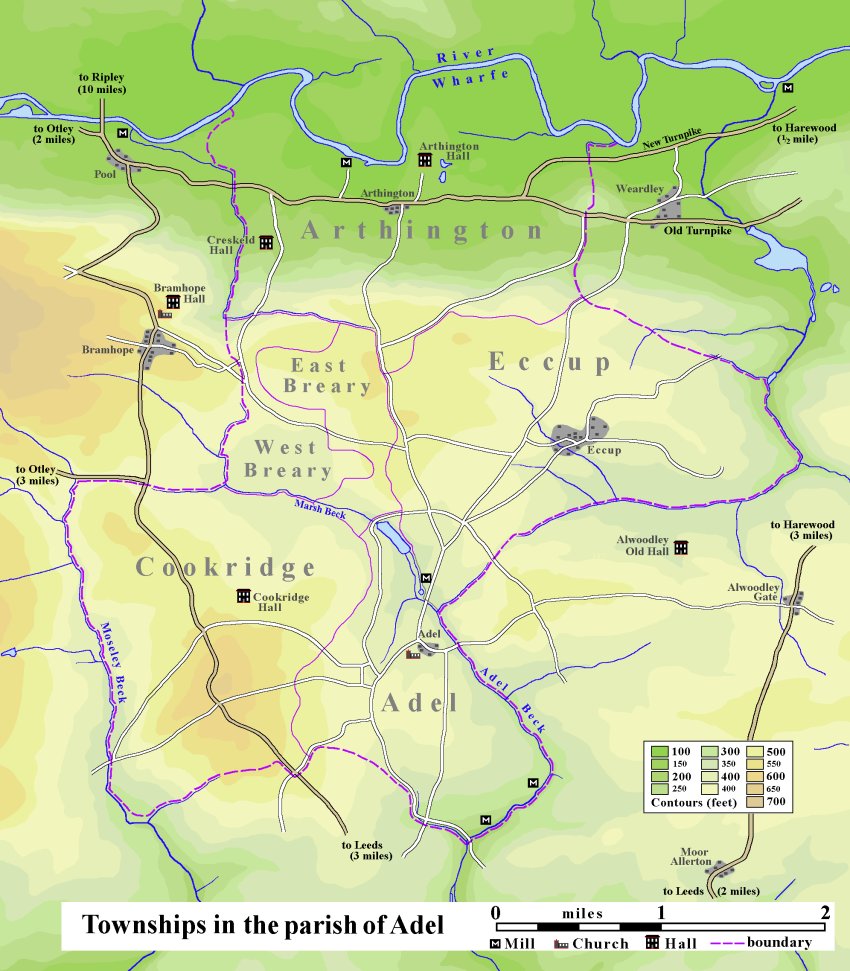Samuel Hearfield was a Christmas baby. He was born on a farm at Arthington, and on a cold January day in 1699 his family carried him up the steep hill of Arthington Bank to be baptised at the parish church in Adel. Now a pleasant suburb of Leeds, Adel (or Addle, as they called it) then was a village out in the country, halfway between Leeds and Otley.
Here is what the district looked like at around the end of the 18th century. Move the cursor over the map to see an enlarged version
I drew this map by combining information from the Ordnance Survey with sketchmaps drawn by Mr. Don Cole, a local resident. He has published a series of booklets on the parish that I found extremely helpful, particularly in identifying the boundaries between the townships: Arthington, Eccup, East & West Breary, Cookridge, and Adel itself.
... and thanks to Scott Kimler of randsco.com for the clever zoom code.
It's important to realise that a 'township' is not the same thing as a town. A township is just part of a parish. It may not contain any towns, or even any villages. It exists purely for administrative convenience. A township is a community, above all else, and the idea seems to have grown out of the old manorial system. To its owner, a manor was a machine for making money, just like a factory. The township of Cookridge, for example, was originally a parcel of land owned by Kirkstall Abbey. The concept of a township must have been based originally on the idea of a large farm - one meaning of the word is 'a farm held in joint tenancy by two or more persons' and in the Gaelic language there is apparently no distinction between the words for 'township' and 'farm'. Perhaps this explains the odd shape of 'East Breary' and 'West Breary' - there is (or was) one large farm in each, but no villages.
Like a manor, a township is to some extent self-governing (particularly in looking after its own poor) through its so-called 'vestry' meetings, which I discuss in more detail here . It had the legal right (and duty) to raise and spend money locally, and for that reason it usually included a village, or a grand house with its estates, or just a large productive farm. The money to feed the poor had to come from somewhere.
The turnpike
I have written more about 18th century roads and also about the parishes' efforts to keep them usable.
A main east-west road had always run through Arthington, linking Otley to Harewood and running onwards to York. It was pretty awful, 'ruinous and bad', so that
... in the Winter Season it is impossible for Waggons or other Wheeled Carriages to pass along the same and very dangerous for travellers ...
The local landowners - including Thomas Arthington and Edwin Lascelles - decided to improve communications by making it a turnpike (I will discuss turnpikes in more detail elsewhere), and an Act was duly shepherded through Parliament. Work began in spring 1753. The trustees erected toll-bars and started charging people to use the road, before it had been significantly improved. Public opinion was outraged.
All the sensible people attributed the dearness of their country to the turnpike roads; and reason speaks the truth of their opinion ... make but a turnpike road through their country and all the cheapness vanishes at once.
Three months later, a mob estimated to be 200 strong demolished the turnpike at Pool, then set off down the road to do the same at Harewood Bridge. But it happened that the trustees had been meeting at Arthington Hall and the two groups confronted each other at Arthington. Eventually, the threats of the rich men on horseback overcame the anger of the poor men on foot, and the mob dispersed. They tried again the following day, though.
In the month of June 1753 an attempt was made by a large body of rioters to pull down several of the new toll bars. The first attack was made on the bar near Harewood bridge; but this was successfully resisted by Mr. Edwin Lascelles, afterwards the first Lord Harewood, who armed his tenants and workmen, repulsed the rioters, and after some skirmishing took about thirty of them prisoners .
Lascelles was not a man to let public opinion get in his way. When he built his splendid new house at Harewood a few years later, he insisted that the village of Harewood should be knocked down and rebuilt further away, and also that the turnpike should be re-routed so that it didn't go right past his front door.
Addle?
Adel (or Addle, as they used to spell it) is a funny name to give a village, when you think about it. 'Addle' apparently means 'empty, vain, muddled, unsound'. Addled eggs are rotten eggs. The word originally meant 'a marshy place' according to one source, but it gets worse - my dictionary of Old English says 'adl' was the word for 'disease'. It doesn't sound very welcoming.
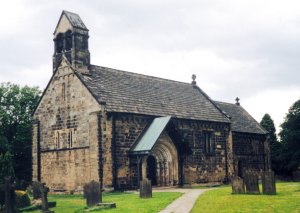
The Romans arrived there eventually, despite the name, which they naturally changed. In about 200 AD they set up a small quern-making operation (a quern was a hand-mill for grinding small quantities of grain - an early version of those enormous pepper-grinders flourished by waiters in Italian restaurants) but they don't seem to have stayed for long. After they left, the thrifty locals pinched their stone altars and built them into the church.
In the 11th century, when the church was built to serve the newly-created parish of Adel, the Domesday Book says that most of the parish belonged to the Count de Mortain (the King's half-brother), and was run by one Richard de Surdeval. The manors of 'Ardington', 'Adele', 'Cucheric' (Cookridge) and 'Echope' were all his (together with 'Burgedurum' which seems to have been some land between Eccup and Harewood), whilst the adjoining lands were not.
The remaining township - Breary - is not mentioned, and perhaps that was because part of it was marshland and nobody wanted it. (They still don't. Breary Marsh is now a nature reserve.) And yet Breary became a separate township, so the land must have been useful enough to attract people to settle there. The Cistercian monks of Kirkstall Abbey certainly thought so, for they established Breary Grange, one of many farms they came to own in the parish. The farm is still there. In fact, Kirkstall Abbey became one of the biggest landowners in the district. By 1459, when the manor of Leeds was generating £70 or £80 a year, the Abbey's income from rents was five times as much. Eighty years later Henry VIII confiscated and sold this land, and amongst those who bought it were the Arthington family (who lived, as you might expect, in Arthington Hall). It seems quite likely that this family employed my ancestor.
The flood of 1829
The lake near the centre of my map seems tiny, but in 1829 the people living downstream discovered just how much water it held. According to White's Directory of 1837,
At Black hill, near Addle, there was a large reservoir occupying an extent of from twenty to twenty five acres, and formed by the natural inequality of the ground and a large embankment at the east end about fifteen feet high. This reservoir was situated at the head of the stream known nearer Leeds by the name of Sheepscar beck.
On the evening of July 11, the quantity of water in the reservoir had been materially increased by a heavy fall of rain during a thunder storm, and in the night the embankment gave way. The beck was in a moment increased to a mighty torrent; the fences, the walls, and bridges were carried away, the lands in the valley were covered; the mills by the bed of the stream were overwhelmed, and the goods they contained on their lower floors were either ruined or carried away; the houses and cottages exposed to the inundation were deluged, their contents were destroyed, and many a poor family lost all the clothing and furniture they possessed in the world; in the neighbourhood of Timble bridge and East street, great confusion was occasioned, as some of the inhabitants were in imminent danger of losing their lives, so that altogether this was by far the most calamitous flood that ever occurred in the neighbourhood of Leeds.
A few years later, when it was finally decided to install a municipal water supply system (the previous 'system' was connected to just 2,200 houses in a city with a population of 60,000, says White's) the "eminent engineers" who were given the job recommended tapping the "copious springs" at Alwoodley and Eccup.
Births, marriages and deaths in Adel
In 1822 the population of Arthington was said to be 329. Nobody bothered to do a head-count in 1699 when baby Samuel was born, but the Parish Clerk did scrupulously record births, marriages and deaths in the register. The records cover the period from 1607 to 1812.
I decided to spend a day counting them, to see if the trends in this data could tell me anything useful. First I looked at baptisms and burials.
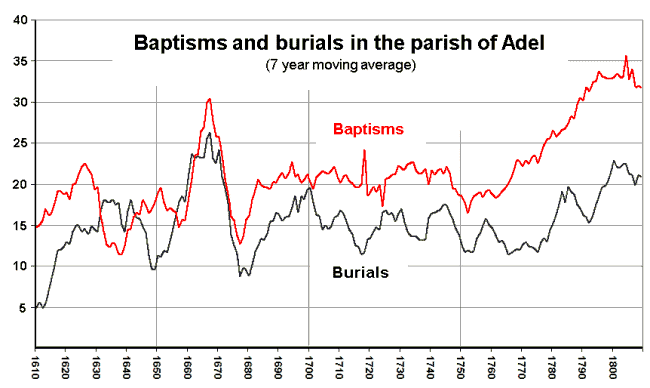
Smoothing out the data like this emphasises the trends, but it does tend to hide what happened in a particular year. For example, when the great plague hit Leeds in 1643-44 and killed over a thousand citizens there - more than 20% of its population - Adel did not escape unscathed. The number of deaths in the parish jumped from 10 in 1642 to 30 the following year, and 23 people were buried in 1644.
The graph shows that there were bad times (like 1635) and good times (1650), but by and large the population remained pretty stable until about 1770. Then, for some reason, it began to grow. More babies were born, and more old people had to be buried.
But - wait a minute - this is exactly the same unexpected change that appears in the population graph here. In the rural parish of Adel, the population began to rise towards the end of the eighteenth century, just as it did right across England!
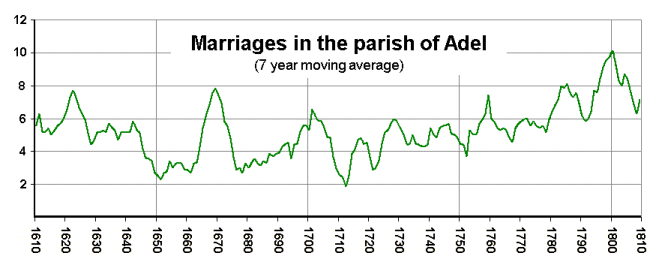
It turned out that the trend in marriages was also one of steadily rising growth, which began apparently as early as 1650, after the end of the dreadful Civil War.
So from this it seems fair to conclude that in 1699 the population of Arthington was somewhere around half its value in 1822 - say, 150 people - so if the average family included three children, this means there were about 30 families. Adel parish was evidently a good place for young couples to marry and bring up their children.
The first railway engine in the world
And now for something completely different ...
Everyone knows that the first railway engine was built by George Stevenson to run on the Stockton and Darlington railway. Like so much that everyone knows, this is simply not true. The first railway engines were in fact designed and built by a self-taught engineer named Matthew Murray, 13 years before Stevenson, and were used to transport coal from a colliery into Leeds. But Murray's claim to fame is much more significant than this. It was his engineering skills that made possible the flax-spinning industry that drove the expansion of Leeds from a town into a city.
And it was in peaceful, rural Adel, of all places, that Matthew Murray made his name.
Murray was born into a working-class family at Stockton-on-Tees in 1763. He grew into a big strong lad, and was apprenticed in due course to a blacksmith. There was no suitable local work for him locally and so, the story goes, he walked south, arriving in Leeds without even the money to pay for a night's lodging. He told the inn-keeper he expected to find work at Marshall's mill, and the next day, he did.
Marshall was a young entrepreneur (two years younger than Murray) who had leased Scotland Mill, in Adel, and was desperately trying to iron out the problems in a new technique for spinning flax into yarn. After two years of effort he was no nearer a solution. There were serious flaws in the 'heckling' process - that is, in cleaning and straightening the fibres ready for spinning - and Murray immediately set to work to identify and correct them.
The key problem was that the yarn produced was of uneven thickness and tended to keep breaking. The fibres in flax, unlike those in cotton or wool, are relatively long and inelastic. Murray realised that the fibres were refusing to stick together properly, and that a better method had to be devised for combing out the unwanted plant debris and pulling the fibres more smoothly off the roller.
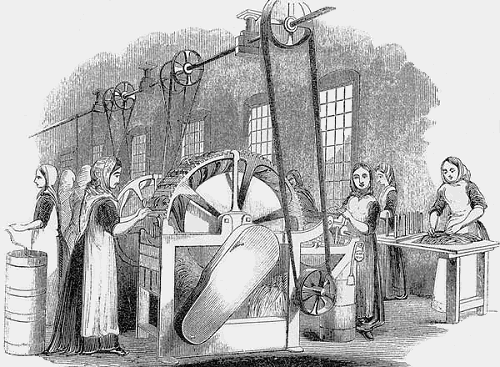
In 1790, just a few months after he had arrived in Adel, he had created an improved machine that could spin flax successfully. A grateful Marshall presented him with £20 and promoted him to the job of First Mechanic in the workshop.
The heckling machine Murray designed looked like this. The drawing appeared in an article about Marshall's mills in The Penny Magazine of 1843.
Now, all this sounds rather improbable, and a cynical person might wonder if there is more to the story. It turns out that it is at least possible that Murray had previously worked on the machine in Darlington, where it was invented (and which had a strong linen industry), and if so he would certainly have known who Marshall was and exactly where to find him. He may also have thought about improvements that might help with the problem. Marshall had been struggling for two years to make the machine work properly, and was in fact being sued by the inventor for £900. Marshall fought the action, and won, but then acknowledged that he wouldn't have been able to pay if he had lost. Murray had arrived just in time.
Marshall had originally entered the flax-spinning business because he saw a gap in the market. He believed that if the mechanical problems could be overcome, as they had been in cotton-spinning machinery, there was a fortune to be made in supplying cheap yarn to the linen-makers. His father had been a linen draper in Leeds, so he knew how the industry worked. When his father died, leaving him several thousand pounds, Marshall persuaded a couple of partners to join him and spent his inheritance on leasing the mill in Adel and negotiating rights to use the machinery.
Once Murray had sorted out the mechanical problems, Marshall had a product to sell, and the orders began to roll in. He quickly realised that he needed much more space. He bought a site in Holbeck and built Temple Mill, four storeys high, and filled it with handlooms, spinning frames and carding engines. Power was supplied by a 20 horse-power Boulton & Watt steam engine. When he'd finished, the firm was £4,000 in debt, and his partners decided it was time to quit. They couldn't have picked a worse moment - the factory was immediately a huge success, and highly profitable. A year or so later Marshall found new partners and began spending their money on building another mill. By 1804 he had made enough money to buy them out. The firm was then employing over 1,000 people, using 150 horse-power from steam engines to drive nearly 7,000 spindles. It was the largest flax spinning operation in the country . In 1820 Marshall was said to be worth over £400,000.
And where Marshall went, others followed. In 1821 there were 19 firms in Leeds spinning flax. By 1855 there were 37.
Like many another factory-owner, Marshall looked on his workforce as just another resource to be exploited as ruthlessly as possible. The conditions in his factories were compared to those of Negro slaves on the plantations. An observer noted that
The hands had very particular printed instructions set before them which are as particularly attended to. So strict are the instructions that if an overseer of a room be found talking to any person in the mill during working hours he is dismissed immediately. Everyone, manager, overseers, mechanics, oilers, spreaders, spinners and reelers, have their particular duty pointed out to them, and if they transgress, they are instantly turned off as unfit for their situation.
In 1826 Marshall decided to enter Parliament in order to find out how the country was actually governed and 'as an introduction to good society'. He bought a seat for 5,000 guineas. His opponents took the opportunity to publish this parody of a nursery rhyme.
Humbly dedicated to Mr. John Marshall, Flax Spinner, Holbeck.
This is the House that Jack built.
This is the Flax all heckled and torn that lay in the House that Jack built.
These are the Children all forlorn, who toil and slave from night to morn, in spinning the flax all heckled and torn, that lays in the House that Jack built.
This is the man, all shaven and shorn, for whom the children all forlorn toil and slave from night to morn, in spinning the Flax all heckled and torn, that lays in the House that Jack built.
This is John Bull, a Freeman born, whom the Man with head all shaven and shorn thinks to lead by the nose while talking of corn, while the poor children, all forlorn, get so little for toiling from night to morn in spinning his flax all heckled and torn, that lays in the House that Jack built.
This is the Lord so very high born, who treated his LONGWOOL friends with scorn, yet has joined the man, all shaven and shorn, to lead John Bull by the nose, by talking of Corn, but if they don't mind they'll be tossed and torn, or be sent with the children all forlorn, to twist from the Flax all heckled and torn, a Rope for to hang themselves some morn, in front of THE HOUSE THAT JACK BUILT.
It made no difference to the election result, of course. And anyway, after four years in Parliament, Marshall had satisfied his curiosity about government. He retired and went to live on the island he had bought in Derwentwater. His son John (junior) took over the factories, and was elected Member of Parliament for Leeds in the reformed House of Commons.
There was talk in Parliament of factory reform, of reducing the working day to ten hours. When this finally crystallised into a Bill, in 1831, it proposed limiting the working day of children in textile factories to 11½ hours on weekdays and 8½ hours on Saturdays, with proper meal-breaks. The Bill was modified at the committee stage so that it applied only to cotton mills. It took the reformers two more years before the Factory Act was passed and the ten-hour day became law.
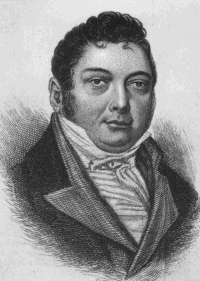
Meanwhile, Murray the engineer had not been idle. Though he remained attached to Marshall's as a sort of consultant, he found partners of his own and by 1795 he had built a factory on adjacent land. The firm of Fenton, Murray & Wood began manufacturing textile machinery and, importantly, steam engines. Within a very few years Boulton & Watt noticed the impact on their sales figures as it became clear that Leeds factory owners preferred to buy from the local firm. Boulton & Watt were not prepared to stand idly by whilst their business was taken away. They bought up the land around Murray's factory to prevent him expanding , and contemplated purchasing an old malthouse next to the works so that, as James Watt (junior) remarked, 'we could overlook their whole yard'.Watt eventually decided that such a move wasn't worth the cost, and instead arranged to gain access to the bedroom of one of Murray's men. There they found treasure - some engineering sketches of their own machinery, with dimensions!
Murray made many improvements to the basic steam engine of the day. He was the first to mount the cylinder in a horizontal plane, and he greatly improved the D valve (the valve that allows steam into the cylinder), though in order to do so, he first had to invent a planing machine.
In 1810 he was approached by the manager of Middleton colliery and asked to design a steam locomotive that could pull coal trucks into Leeds more cheaply than the horses then being used. Murray decided that smooth wheels on a smooth track probably wouldn't cope with the loads, and so a rack railway was built. (This cautious engineering decision is probably why everyone remembers Stevenson instead.) The first trials in 1812 showed that Murray's 5-ton locomotive could pull a load of 90 tons at 4 miles an hour on a level track. The colliery manager was delighted, and ordered another three. They continued in service for the next twenty years.
His firm was asked, many years later, to build locomotives for the Stockton and Darlington railway. They declined. Politely.
Note on sources
- Tracks and roads in a Yorkshire parish, Cole, 1996
- Tour through the southern counties of England, Young, 1769
- Yorkshire past and present, Baines, 1871?
- Topographical dictionary of Yorkshire, Langdale, 1822
- Illustrated history of Leeds, Burt & Grady, 2002
- Flax Spinning in Leeds, Brown, 1821
- Election speeches and squibs 1807-1830, quoted in The textile revolution, Addy, 1976

